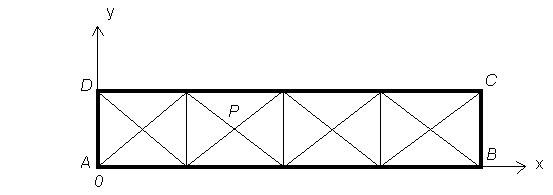3. Modeling A#
3.1. Characteristics of modeling#
The mesh is done using TRIA6 of the D_ PLAN_HM_P modeling.

The aim is to test the solution in terms of movement and pressure given by Code_Aster. We also test the computer non-regression of the calculation of the residual error indicator for permanent HM modeling.
3.2. Characteristics of the mesh#
Number of knots: 43
Number of meshes and types: 16 meshes TRIA6
The mesh is refined uniformly 1 times using HOMARD.
3.3. Tested sizes and results#
Before remeshing
Point |
Component |
Reference |
Code_Aster |
\(\text{\%}\) difference |
\(P\) |
DX |
2.941E-04 |
2.941E-04 |
6E-03 |
\(P\) |
DY |
4E-18 |
0.000 |
|
\(P\) |
|
131249 |
-2E-03 |
We also test the computer non-regression of the global components ESTERG1 and ESTERG2 of the error indicator. Absolute tolerance is therefore severe: \({10}^{-13}\).
Point |
Component |
Code_Aster |
Tolerance |
\(P\) |
Value of ESTERG1 |
9.18E-31 |
|
\(P\) |
Value of ESTERG2 |
4.75E-32 |
|
\(\mathrm{NS7}\) |
Value of ESTERG1 |
9.88E-31 |
|
After remeshing
Point |
Component |
Reference |
Code_Aster |
\(\text{\%}\) difference |
\(P\) |
DX |
2.941E-04 |
2.942E-04 |
0.006 |
\(P\) |
DY |
2E-17 |
0.000 |
|
\(P\) |
|
131249 |
-9.3E-04 |
We also test the computer non-regression of the global components ESTERG1 and ESTERG2 of the error indicator. Absolute tolerance is therefore severe: \({10}^{-13}\).
Point |
Component |
Code_Aster |
Tolerance |
\(P\) |
Value of ESTERG1 |
6.79E-31 |
|
\(P\) |
Value of ESTERG2 |
9.34E-33 |
|